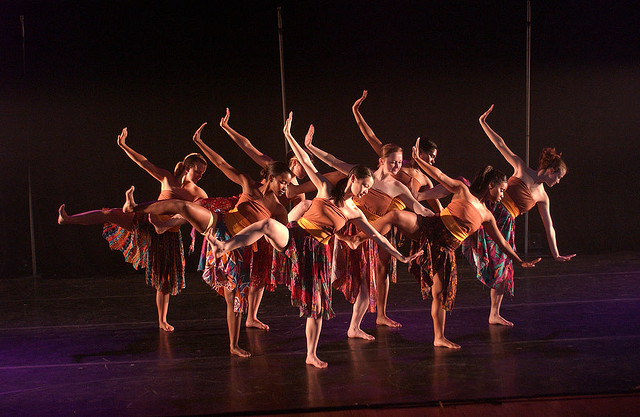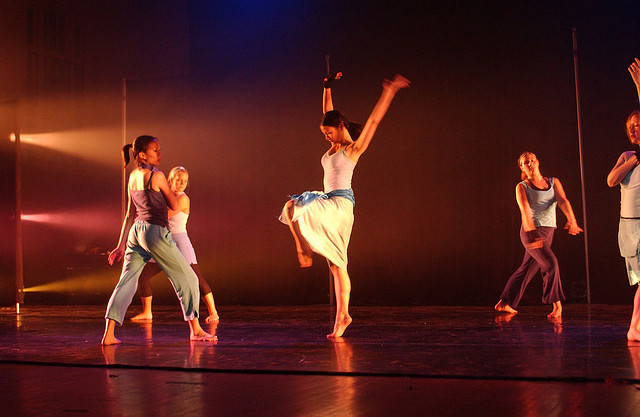
by Janet Rothwell
As a high school dance educator I am responsible for choreographing four or five dances each year for various performances. Although choreography is my favorite aspect of dance, it can be challenging to come up with new ideas, movement, spatial designs, beginnings, endings, and themes each year. As someone who values originality and the creative process, I have realized there are certain things I do to help me stay organized and creative in my work.
Over the years I have adjusted my process to include some staple methods so as to not get burnt out with repeating the same movement or spatial pattern every time I choreograph a piece. I thought I would share these specific parts of my choreographic process that seem to aid me each year as I strive to maintain newness in my artistry.
1. Maintain a choreography journal
My choreography journal is my best friend in my creative process. Not only do I use it daily while choreographing works, but I use it year round to write down ideas that pop up at random times for future works too. I write down music I like or ideas I have for themes so that when I have to create a new dance and I feel uninspired or stuck trying to think of something, I can go to my journal and look at the running list of things I have written.
I find that my choreography journal is extremely helpful for me to remember what is happening in the dances I create with my students. When I’m juggling three or more pieces at once it’s difficult to remember what choreographic elements I have already used with other dances, and since I value being original and unique with my choreography I write everything down in my journal. I make drawings of spatial designs, describe movement ideas, brainstorm titles, take notes on my music, and write down costume ideas. I also make notes on what I want to do for the next day so that when I return to my students I can take a look at my journal and know where we are in the work and in the music.
A choreography journal does not have to be pen and paper either, although I find that’s what works for me. You could use a tablet, your phone, or whatever tool you like to work best in your process. However, I would say that staying consistent is best to keep organized. There is nothing worse than having written down great notes only to have misplaced loose papers or random receipts you wrote them on. I keep an actual journal so that all of my ideas are in one place and easy to find.
2. Pick clear themes and diverse music for each dance
When creating multiple dances at once, I make a point to pick out music and themes that are very different from one another. For example, this past school year I had to choreograph four dances and each piece needed to be unique and original. I used a Frank Sinatra song, an African folk song, a cello piece by Phillip Glass, and a heavy drumming song. Having these distinct pieces of music helps me to organize my choreography for each dance so that no two works get muddled together.
I also work with my students to pick a clear theme for our dance. We explore how the music feels and what imagery we see when listening to it. I ask them questions like: “What is the dance about? What is the purpose? What do we want our audience to walk away saying or feeling after experiencing our dance?” For example, the African folk song piece was about children’s play time at recess while the heavy drumming piece was about competition. Having a clear theme also helps teach my students about choreography and how we communicate our ideas and messages.
3. Create a clear movement motif and have students assist with movement development
I’ll admit it, sometimes I unintentionally repeat myself or sometimes I do the same movement over and over again and it’s hard to always be fresh with my movement ideas. Having a clear motif helps me to evolve my own choreography and movement invention. I find that my students are a wonderful resource for movement invention as well. They come up with amazing and original movement. This is so wonderful because they have a more vested interest in the success of the dance if they have created parts of it.
4. Be a director
I make a choice to involve my students in the choreographic process the whole time. I do not come into the classroom and set the whole work on them. It is important to me that my students learn about how to use choreography tools with space, time, and energy. I task my students out on small movement assignments to aid in the choreographic process and they create sections of movement for the dance. I decide where those sections should go and change them as needed for the work.
For example I might ask a trio to come up with a traveling phrase that goes into the floor, while another group of four will create a stationary phrase focusing on using different energy qualities and having moments of contact with one another. As a director I have final say as to what is performed and how the whole dance is put together.
5. Pick the best dance for your class
Every class I teach has its own personality. Some of my classes are more adventurous risk takers while others can find humor in everything. I pick a theme or music for my classes with their personality in mind. I want my students to have fun and be successful so it is important to think about what type of dance and movement they could perform really well. Sometimes I’ll ask my students if they have ideas or I’ll give them two different options and take a class vote.
As artists we are always seeking to create newness and fresh works. I truly enjoy choreography with my students each and every time. I hope to teach them to love the process just as much as the product and performance.


Contributor Janet Rothwell has been a dance educator for 10 years. She has taught modern, ballet, and jazz at various studios and schools on Chicago’s North Shore. She received her MA in Dance with an emphasis in Choreography from the University of North Carolina-Greensboro and her BA in Communications with a Dance Minor from the University of Wisconsin-Madison. Throughout her time in graduate school, Janet performed with Sidelong Dance Company based in Winston-Salem, NC.
Currently, Janet teaches dance at Loyola Academy High School in Wilmette, IL. She is the Director of Loyola Academy Dance Company B and the Brother Small Arts Guild, and choreographs for the Spring Dance Concert and school musical each year. Janet is very active within the Loyola Academy community leading student retreats and summer service trips. She regularly seeks out professional development opportunities to continue her own artistic growth. Recently, Janet performed with Keigwin and Company in the Chicago Dancing Festival 2012 and attended the Bates Dance Festival.
When she isn’t dancing, Janet enjoys teaching Pilates, practicing yoga, and running races around the city of Chicago.




